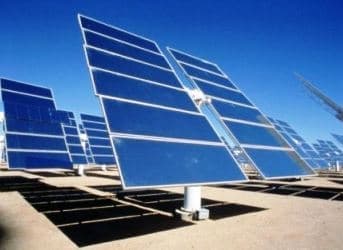The US solar industry is undergoing some serious growing pains, with bankruptcies and mergers a necessary part of that process; meanwhile, competition from Chinese solar panels has many believing that American solar simply cannot compete. Not so.
Solar’s track record is certainly not inspiring: The past couple of years have seen a number of high-profile bankruptcies, including Solyndra, Q-Cells, Evergreen Solar and Abound Solar. At the same time, while Chinese solar companies have managed to avoid bankruptcy, they are in trouble and are posting sharp losses, and debts are not government-owned as most might think. Perhaps the Chinese government will bail these heavily subsidized solar companies out, but not necessarily as such a move would further imbalance the solar market.
While solar installers have benefitted from the market, US solar manufacturers have taken a hit, with solar panel prices falling by some 47% over last year due to global oversupply.
Quite simply, competition means that solar companies will have be a bit more innovative in reducing costs and improving efficiency.
Not all solar companies are going under: First Solar is doing fine. First Solar has net debt, indeed, but it stands to have a positive cash flow for the next two years. Two other companies, SunPower and Trina Solar, are also projecting a return to profitability for 2013. By 2014, First Solar will be restructured into a utility-focused company, giving up the rooftop solar market. This is how it is adapting and changing with the market.
Solar companies will not be successful until they give up on markets in which their only recourse for competing is through government subsidies. This mindset is what is weeding out the future solar winners from the losers.
General Electric was hoping to produce thin-film solar panels which are less bulky and more efficient than conventional solar panels. GE was hoping to be able to produce these panels at a low enough price as to be attractive to the average homeowner. However, those plans have been delayed (not scrapped) because of the falling price of thin-film panels to the point that GE cannot cover the cost of producing them. Still, GE is not ready to throw in the towel. Instead, it’s planning to improve its technology in order to increase production efficiency to rival its Chinese competitors. It’s called innovation and it is essential for competition—subsidies or no.
Things are not as bad as they seem. According to a recent report from GTM Research and the solar Energy Industries Association, the first quarter of 2012 was one of its best in terms of installation (506 mw to power over 350,000 homes). Furthermore, installed solar power is forecast to increase 75% in 2012, adding another 3.3 gigawatts of solar power to the current 4.4 gigawatts already installed across the country. But the rooftop installation market will not be forging solar’s future in the US. The future will be in solar power installation by big utility companies. While this category saw installation decline sharply in late 2011, the scale and scope of these projects is vast and construction time-consuming, so quarterly figures are not as relevant.
There are also alternatives to subsidies that solar power could latch on to. The Solar Renewable Energy Certificates (SREC) program grants anyone who installs solar access to the state market to sell credits for every 1,000 kilowatt-hour of electricity generated. This is currently on offer in New Jersey, and other states are considering similar programs.
Slapping harsh tariffs on Chinese solar panels was the result of some heavy-handed lobbying led most relentlessly by German-owned SolarWorld AG, which is now planning to file an anti-dumping case against Chinese firms in the European market.
According to SolarWorld, the company will pursue “anti-subsidy” and “anti-dumping” cases against Chinese solar panel manufacturers in Europe in cooperation with a coalition of European manufacturers.
This is a rather rich move coming from a company that has itself been built on government subsidies.
It also comes on the heels of a decision by the US Commerce Department in May to impose a 31% tariff on the main Chinese manufacturers of solar panels in the US—a move led by petitioning efforts from SolarWorld’s US branches.
China is not entirely to blame for the global oversupply, of course. All manufacturers continued to produce massive quantities of solar panels despite overstocked inventories.
What most fail to understand, however, is that the US wants (and needs) Chinese clean-energy cash in order to make its clean-energy ambitions a reality—especially at a time when federal subsidies are dwindling.
More important than the solar panel dumping debate is what China can do for the US clean energy industry through cash investments—and China is aggressively pursuing this avenue with the American blessing. China invested $264 million last year in renewable-energy deals in the US. Beijing-based GSR Ventures, from its offices in Silicon Valley, helped fund electric battery manufacturer Boston-Power Inc’s move into China. Meanwhile, San Francisco has come up with the ChinaSF program, whose ultimate goal is to lure Chinese investment in clean energy.
In the end, it will be Chinese cash and American access to (massive) Chinese consumers for clean-energy products that saves the industry and allows it to gain a competitive edge over fossil fuels.
As such, slapping tariffs on Chinese solar panels for “dumping” is tantamount to biting the hand that will feed the US clean-energy industry. And as for US solar panel manufacturers, well, competition means finding ways to survive in the real market, beyond subsidies that were never intended to last forever. Solar companies must adapt or shut down.
By. Charles Kennedy


















